| These are just a few suggestions
and recommendations of places that our guests in the past have
enjoyed:
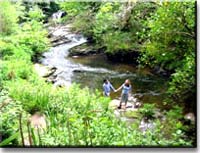 Clare
Glens. Clare
Glens.
The Clare Glens through which the
Clare river flows, is a gorge that has many waterfalls and
provides excellent "adventure" walks. The wooded
nature trail has been mapped out in a looped course format,
which opens up all areas of the Glens to the visitor. The
river Clare forms the boundary between Co. Limerick and Co.
Tipperary and is located 15 minutes drive from these houses,
just outside Newport.
Silvermines
This pretty village lies at the foot of the Silvermines
Mountains. For 700 years, both open-cast and underground
mining was carried out by different groups, evidence of
which still exists today. The Viewing Point at Step, just
above the village provides magnificent views into 4 counties! |
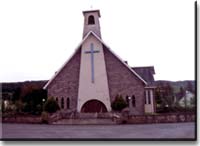
Silvermines Church |
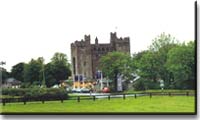 Bunratty
Castle and Folk Park Bunratty
Castle and Folk Park
Bunratty Castle and Folk Park is one of Ireland's top visitor
attractions. A visit to the castle, the most complete and
authentic mediaeval fortress in Ireland, and the Folk Park
nearby, is a wonderful experience for all the family. Bunratty
Castle is located less that 1 hour drive from the houses.
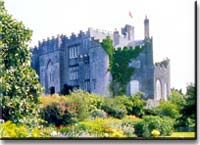 Birr
Castle Birr
Castle
Birr Castle, with its beautiful gardens and interesting museum
is located just one hour drive away and is well worth a visit.
Many of our guests in the past have enjoyed
seeing the Dolphins off the Coast of Co. Clare. Tours
leave from the harbour town of Kilrush, a little more than
an hour away.
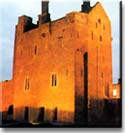 Roscrea
Castle Roscrea
Castle
This castle is also steeped in history and legend. King
John allegedly built it in 1213. At one corner is a tall rectangular
tower with a fine vault and a fireplace on the second floor.
The upper floors have an unusual selection of passages and
stairs leading to various defensive positions, but some parts
of the uppermost storey date from the 16th century. The curtain
wall surrounding the enclosure is reached from the first floor
of the tower. In the wall of the castle facing on to the street
there are holes, which indicate the place where the drawbridge
to the castle once stood. Dominating the heart of Roscrea
town, this 13th century state-of-the-art royal castle and
definitely well worth a visit!
King John`s Castle
King John`s Castle in Limerick has an interesting museum and
multimedia exhibition and is a good option for when the sun
is not shining.

"Lar na Pairce" is the museum
of the Gaelic Athletic Association (GAA), located
in Thurles, just 45 minutes away. This is a great place about
our National games including Hurling and Gaelic Football,
as this is the Birthplace of the GAA.
Lime kiln
This Lime Kiln is situated a short distance walk from
Killoscully village. In years gone by, the people of this
area used lime to fertilize their land. Indeed, it is still
often used today, however the way in which it is acquired
has changed somewhat!
This is a description of the way in which
the Lime was processed at the Lime Kiln close to Killoscully
Village.
The rock needs to be broken into quite small
pieces to have a successful burning. The limestone in the
Killoscully/ Ballinahinch region is white and soft and easier
to convert  into
lime that for example, the black limestone in parts of east
Co. Clare. To burn the lime, a black bituminous dust called
Colum was used. This was produced in the coal mining area
of Castlecomer, Co. Kilkenny and was ferried to this part
of Ireland by train. There was a station situated close to
Shallee Cross. It was necessary to collect this fuel at Shallee.
It should be noted that mechanisation which is so much part
of such operations nowadays was not widespread in those times.
The working of a kiln involved backbreaking manual labour,
which is unlikely people would relish today. It is possible,
for example, that workers at the Kiln would fill a load of
turf, and deliver it, go on to the Railway station, fill a
load of colum, return to the Kiln before emptying the load
in the field beside the kiln. All loading and unloading was
done by hand. It was often past midnight before they finished.
Procuring the limestone was not a task for the fainthearted.
Another trip (this time on the bicycle) was necessary to get
the gelignite. While a permit was required, the tight restrictions
in force today did not apply. into
lime that for example, the black limestone in parts of east
Co. Clare. To burn the lime, a black bituminous dust called
Colum was used. This was produced in the coal mining area
of Castlecomer, Co. Kilkenny and was ferried to this part
of Ireland by train. There was a station situated close to
Shallee Cross. It was necessary to collect this fuel at Shallee.
It should be noted that mechanisation which is so much part
of such operations nowadays was not widespread in those times.
The working of a kiln involved backbreaking manual labour,
which is unlikely people would relish today. It is possible,
for example, that workers at the Kiln would fill a load of
turf, and deliver it, go on to the Railway station, fill a
load of colum, return to the Kiln before emptying the load
in the field beside the kiln. All loading and unloading was
done by hand. It was often past midnight before they finished.
Procuring the limestone was not a task for the fainthearted.
Another trip (this time on the bicycle) was necessary to get
the gelignite. While a permit was required, the tight restrictions
in force today did not apply.
Here is a recount of the method of blasting.
The gelignite was inserted with the detonator and fuse attached.
You lit the fuse with a match. Sometimes the match would not
remain lighting so you lit a cigarette and applied the burning
end to the fuse. It was then time to run - as fast as you
could! When you heard the blast you stopped and looked up
in case any stray rock would land on you from above. On occasion,
too much gelignite may be used. In this case the whole townsland
would reverberate and cups and plates on a dressing tables
in nearby houses would go crashing to the floor.
| The broken rock was transported
to the kiln. Rocks were broken into small pieces for the
furnace. If a rock was too large it would not completely
burn and would emerge from the kiln as a hard lump. These
lumps were known as 'Coddlers' and were quite useless.
They would not burn again. A half creel of turf and timber
was placed at the base of the kiln. Then alternate layers
of stone and colum were put in the kiln until full. A
covering of clay sealed the top. It might take a week
to burn a full kiln and it needed regular attention to
ensure a good, even burn. From blasting to shovelling
colum to handling dusty lime, the work was not altogether
conducive to good health. Limekilns are a relic of previous
centuries. As we view those that remain we can only marvel
at the skill of those who built and operated them. We
must also ensure that they are preserved. |
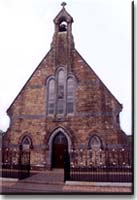
Ballinahinch Church |
|